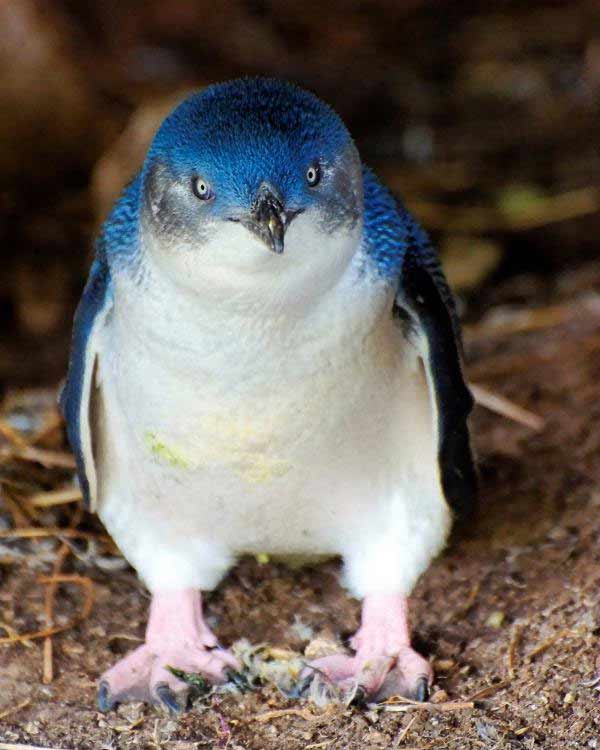Dapper Blue Penguin: Tux Is a Feathery First

If these penguins look blue to you, it's not because they are down in the dumps. They have a special protein structure in their feathers that generates the blue color by reflecting light in a way that has never been seen in feathers before.
Lead author Matthew Shawkey of the University of Akron was surprised to find the new structures, which "shatter current dogma," Shawkey told LiveScience. "We found a previously undescribed way that birds make a non-iridescent blue color in feathers."
Shawkey found the structure in feathers of the blue penguin, a bird commonly found in Australia and New Zealand and also called the little, or fairy, penguin, awkwardly stands about a foot tall (30 cm) and weighs a little more than 2 pounds (about 1 kg). They have the traditional tuxedo look of penguins, though their feathers are a non-iridescent dark blue.
For the last 30 years only two ways of making a non-iridescent blue feathers were known, both which depend on holes in a spongy-like matrix of a protein called beta-keratin. The pores in the matrix trap and reflect light in the blue color range. "When I first looked at them [the feathers] I expected them to be one of these other two mechanisms," Shawkey said to LiveScience.
In the blue penguin feathers, the beta-keratin is aligned into parallel fibers, like a row of hairs. The alignment and size of the fibers scatters the light and reflects those in the blue pigment range. This is the first time this organizational structure has been seen to produce color in feathers.
"The mechanisms that produce structural coloration in animals is so little studied that I am not surprised at all that a new mechanism was found in penguins," Geoffrey Hill at Auburn University in Auburn, Ala., who was not involved in the study. "Shawkey and Prum are like the first Europeans who came ashore in North America and had a vast uncharted realm to explore."
Ancient pigments
Get the world’s most fascinating discoveries delivered straight to your inbox.
The discovery was not only a surprise in itself but an unexpected find to Shawkey, who stumbled upon the odd structure during the course of another project. After some recent work reconstructing the color of ancient dinosaur feathers, Shawkey moved on to analyzing the color of some 35 million-year-old penguin feathers, which required his team to analyze the color-producing pigments and proteins in living penguins.
When his team took a look at what made the blue penguin's feathers blue, he was shocked. "These fibers were unexpected, they look totally different than anything we ever seen before," he told LiveScience.
The team looked at how these filaments scattered light and X-rays to determine what the structures look like and figure out how they were producing the blue color. They saw that the structure was highly organized; It looked a lot different than the spongy, disordered keratin structures that have been observed to create colors in feathers before.
The 160-nanometer keratin filaments lined up in an array that Shawkey describes as "a handful of uncooked spaghetti." They also saw that how the filaments were lined up would create a blue color reflection. Hundreds of the fibers line up side by side in the cells that make up the feather's barbs — the silky fibers that branch off of the quill.
"The significance lies in the realization that there are many ways to use nanostructures to produce blue color," Hill told LiveScience in an e-mail. "The research underscores that we should keep investigating structural coloration in diverse animals to see what other ingenious mechanisms natural selection has produced."
Evolving technologies
Beta-keratin is known to self-assemble fibers and Shawkey said that this parallel arrangement might have evolved from that ability of beta-keratin. If the structure does assemble itself, instead of needing a cellular scaffold, it could be easily manufactured. "There might be some interest in mimicking these for applications from things like cosmetics to fiber-optic cables," Shawkey told LiveScience. "If they are self- assembled it would be interesting because it would be cheap to manufacture them."
Shawkey also wonders if this organization somehow gives the penguin feathers special benefits, like additional strength or rigidity to withstand flying through the water, which is 1,000 times more viscous than the air birds normally fly through.
While this is the first time this sort of structural formation of blue color has been seen in feathers, a similar method of color production has been seen in blue skin of birds, though in that case the fibers are made up of collagen.
"Both beta-keratin and collagen have an innate tendency to self-assemble into fibers, so it makes sense that you would find these nanofibers made from both beta-keratin and collagen." The two structures seem to be an example of convergent evolution, when two structures evolve separately but use the same mechanism, he said.
You can follow LiveScience Staff Writer Jennifer Welsh on Twitter @microbelover.
Jennifer Welsh is a Connecticut-based science writer and editor and a regular contributor to Live Science. She also has several years of bench work in cancer research and anti-viral drug discovery under her belt. She has previously written for Science News, VerywellHealth, The Scientist, Discover Magazine, WIRED Science, and Business Insider.



